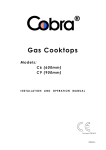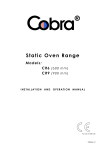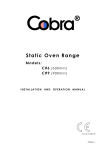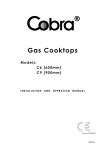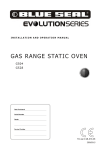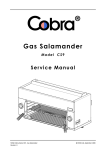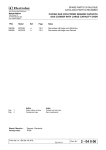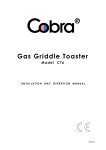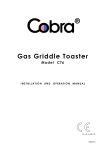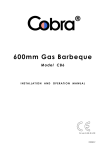Download Cobra C6 Specifications
Transcript
Gas Cooktops Models: C6 (600mm) C9 (900mm) INSTALLATION AND OPERATION MANUAL For use in GB & IE 230635-7 MANUFACTURED BY Moffat Limited Christchurch New Zealand INTERNATIONAL BRANCHES AUSTRALIA Moffat Pty Limited E.Mail: Main Office: Service: Spares: Customer Service: [email protected] (tel) (03) 9518 3888 (fax) (03 9518 3833 (tel): 1800 622 216 (tel): 1800 337 963 (tel): 1800 335 315 (fax): 1800 350 281 CANADA Serve Canada Web: E.Mail: Sales: Service: www.servecanada.com [email protected] (tel): 800 551 8795 (Toll Free) (tel): 800 263 1455 (Toll Free) NEW ZEALAND Moffat Limited Web: E.Mail: Main Office: www.moffat.co.nz [email protected] (tel): 0800 663328 UNITED KINGDOM Blue Seal Web: E.Mail: Sales: Spares: Service: www.blue-seal.co.uk [email protected] (tel): 0121 327 5575 (fax): 0121 327 9711 (tel): 0121 322 6640 (fax): 0121 327 9201 (tel): 0121 322 6644 (fax): 0121 327 6257 UNITED STATES Moffat Inc Web: Sales: Service: www.moffat.com (tel): 800 551 8795 (Toll Free) (tel): 336 661 1556 (fax): 336 661 9546 (tel): 800 858 4477 (Toll Free) (tel): 366 661 1556 (fax): 336 661 1660 INTERNATIONAL Moffat Limited Web: E.Mail: www.moffat.co.nz [email protected] The reproduction or copying of any part of this manual by any means whatsoever is strictly forbidden unless authorized previously in writing by the manufacturer. In line with policy to continually develop and improve its products, Moffat Ltd. reserves the right to change the specifications and design without prior notice. © Copyright Moffat Ltd. April 2014. Contents C6 Gas Cooktops 600mm Wide. C9 Gas Cooktops 900mm Wide. Part 1 Introduction ..................................................................................... 2 Part 2 Specifications ................................................................................. 3 Part 3 Installation ........................................................................................ 6 Part 4 Operation ......................................................................................... 9 Part 5 Cleaning and Maintenance......................................................... 11 Part 6 Gas Conversion ............................................................................. 14 Part 7 Replacement Parts List .................................................................. 20 Part 1 Introduction We are confident that you will be delighted with your Cobra Series Cooktop, and it will become a most valued appliance in your commercial kitchen. To ensure you receive the utmost benefit from your new Cobra Series Appliance, there are two important things you can do. Firstly: Please read this instruction book carefully and follow the directions given. The time taken will be well spent. Secondly: If you are unsure of any aspect of the installation instructions or performance of your appliance, contact your Cobra Series dealer promptly. In many cases a phone call could answer your question. CE Only: These instructions are only valid if the country code appears on the appliance. If the code does not appear on the appliance, refer to the supplier of this appliance to obtain the technical instructions for adapting the appliance to the conditions for use in that country. WARNING: IMPROPER INSTALLATION, ADJUSTMENT, ALTERATION, SERVICE OR MAINTENANCE CAN CAUSE PROPERTY DAMAGE, INJURY OR DEATH. READ THE INSTALLATION, OPERATING AND MAINTENANCE INSTRUCTIONS THOROUGHLY BEFORE INSTALLING OR SERVICING THIS APPLIANCE. WARNING: INSTRUCTIONS TO BE FOLLOWED IN THE EVENT THAT THE USER SMELLS GAS ARE TO BE POSTED IN A PROMINENT LOCATION. THIS INFORMATION CAN BE OBTAINED BY CONSULTING THE LOCAL GAS SUPPLIER. WARNING: GREAT CARE MUST BE TAKEN BY THE OPERATOR TO USE THE EQUIPMENT SAFELY TO GUARD IT AGAINST RISK OF FIRE. THE APPLIANCE MUST NOT BE LEFT 'ON' UNATTENDED. IT IS RECOMMENDED THAT A REGULAR INSPECTION IS MADE BY A COMPETENT SERVICEMAN TO ENSURE THAT CORRECT AND SAFE OPERATION OF YOUR APPLIANCE IS MAINTAINED. DO NOT STORE OR USE GASOLINE OR OTHER FLAMMABLE VAPOURS OR LIQUIDS IN THE VICINITY OF THIS OR ANY OTHER APPLIANCE. DO NOT SPRAY AEROSOLS IN THE VICINITY OF THIS APPLIANCE WHILE IT IS IN OPERATION. C AUTIO N : This appliance is; For professional use and is to be used by qualified persons only. Only Qualified service conversion operations. Components having adjustments protected (e.g. paint sealed) by the manufacturer should not be adjusted by the user / operator. DO NOT operate the appliance without the legs supplied fitted. persons are to 2 carry out installation, servicing and gas Part 2 Specifications Model Covered in this Specification C6D [1] Cooktop C6C [1] Cooktop C6B Cooktop 4 Open Burners. 2 Burners + 300mm Griddle. 600mm Griddle. C9D [1] C9C [1] C9B [1] C9A 6 Open Burners. 4 Burners + 300mm Griddle. 2 Burners + 600mm Griddle. 900mm Griddle. Cooktop Cooktop Cooktop Cooktop [1] - Open Burner Options:F - With Flame Failure Protection. - Standard Burners. General A heavy duty, high efficiency Cooktop for modular kitchens. It has a high option Cooktop / Griddle arrangement and is available on adjustable front feet and robust rear rollers. Five griddle options with 2 models of base unit are available. Fitted with 'Individual Flame Failure' Option (F) for each open burner. (Standard for UK - Optional for Non UK) Griddles are fitted with pilot, flame failure and piezo ignition as standard. These cooktops have an easy clean stainless steel external finish. Gas Supply Requirements - Australia: Input Rate (N.H.G.C.) Supply Pressure Burner Operating Pressure (*) Gas Connection Natural Gas LP Gas (Propane) Open Burner Griddle Open Burner Griddle (each) (each 300mm section) (each) (each 300mm section) 22 MJ/hr 20 MJ/hr 22 MJ/hr 20 MJ/hr 1.13 - 3.40 kPa 2.75 - 4.50 kPa 1.0 kPa (*) 2.6 kPa (*) ¾” BSP Male - New Zealand: Input Rate (N.H.G.C.) Supply Pressure Burner Operating Pressure (*) Gas Connection Natural Gas LP Gas Open Burner Griddle Open Burner Griddle (each) (each 300mm section) (each) (each 300mm section) 22 MJ/hr 20 MJ/hr 22 MJ/hr 20 MJ/hr 1.13 - 3.40 kPa 2.75 - 4.50 kPa 1.0 kPa (*) 2.6 kPa (*) ¾” BSP Male - United Kingdom: Heat Input (net) Gas Rate (net) Nominal Reduced Nominal Reduced Supply Pressure Burner Operating Pressure (*) Gas Connection Natural Gas (G20) Propane (G31) Open Burner Griddle Open Burner Griddle (each) (each 300mm section) (each) (each 300mm section) 5.0 kW 5.0 kW 4.6 kW 5.0 kW 1.7 kW 1.5 kW 1.5 kW 2.2 kW 0.53 m3/hr 0.36 kg/hr 0.39 kg/hr 0.53 m3/hr 0.16 m3/hr 0.12 kg/hr 0.17 kg/hr 0.18 m3/hr 20 mbar 37 mbar 10 mbar (*) 28 mbar (*) ¾” BSP Male NOTE: (*) Measure burner operating pressure at manifold test point with two burners operating at full setting. Operating pressure is ex-factory set, through the appliance regulator and is not to be adjusted, apart from when carrying out gas conversion, if required. (Refer to ‘Gas Conversion’ section for further details). 3 Part 2 Specifications - All Other Markets: Natural Gas Town Gas Input Rate (N.H.G.C.) Supply Pressure Burner Operating Pressure (*) Gas Connection Open Burner Griddle Open Burner Griddle (each) (each 300mm section) (each) (each 300mm section) 22 MJ/hr 20 MJ/hr 22 MJ/hr 20 MJ/hr 1.13 - 3.40 kPa 0.75 - 1.50 kPa 1.0 kPa 0.63 kPa ¾” BSP Male Input Rate (N.H.G.C.) Supply Pressure Burner Operating Pressure (*) Gas Connection Open Burner Griddle Open Burner Griddle (each) (each 300mm section) (each) (each 300mm section) 22 MJ/hr 20 MJ/hr 22 MJ/hr 20 MJ/hr 2.75 - 4.50 kPa 2.75 - 4.50 kPa 2.6 kPa 2.6 kPa ¾” BSP Male LP Gas (Propane) LP Gas / Butane NOTE: (*) Measure burner operating pressure at manifold test point with two burners operating at 'High Flame' setting. NAT, LPG & Butane Only - Operating pressure is ex-factory set and is not to be adjusted, apart from when converting between gases, if required. (**) TOWN GAS Only - Burner operating pressure is to be adjusted using the adjustable gas regulator supplied. Refer to the ‘Gas Conversion and Specifications’ section in this manual for further details. Gas Connection Gas supply connection point is located at rear of appliance, approximately 130mm from right hand side and 630mm from floor. It is reached from beneath the appliance. (Refer to ‘Dimensions’ section). Connection is ¾" BSP male thread (for all models). 4 Part 2 Specifications Dimensions C6 - Gas Cooktop - 600mm Wide. C6D Model C6C Model C6B Model C9 - Gas Cooktop - 900mm Wide. 5 C9D Model C9C Model C9B Model C9A Model Part 3 Installation Installation Requirements Location NOTE: It is most important that this appliance is installed correctly and that the operation is correct before use. Installation shall comply with local, gas and health and safety requirements. 1. Installation must allow for a sufficient flow of fresh air for the combustion air supply. Combustion Air Requirements Natural Gas LPG / Propane This appliance shall be installed with sufficient ventilation to prevent the occurrence of unacceptable concentrations of health harmful substances in the room, that the appliance is installed in. 2. Installation must include adequate ventilation means, to prevent dangerous build up of combustion products. 3. Never directly connect a ventilation system to the appliance flue outlet. 4. Position the appliance in its approximate working position. 5. All air for burner combustion is supplied from underneath the appliance. The legs must always be fitted and no obstructions placed on the underside or around the base of the appliance, as obstructions will cause incorrect operation and / or failure of the appliance. 6. Components having adjustments protected (e.g. paint sealed) by manufacturer are only allowed to be adjusted by a qualified service agent. They are not to be adjusted by the installation person. Cobra Series Cooktops are designed to provide years of satisfactory service and correct installation is essential to achieve the best performance, efficiency and trouble-free operation. This appliance must be installed in accordance with National installation codes and in addition, in accordance with relevant National / Local codes covering gas and fire safety. Australia: AS 5601 - Gas Installations. New Zealand: NZS 5261 - Gas Installation. United Kingdom: Gas Safety (Installation and Use) Regulations 1998. BS6173 34 m³/hr minimum. 36 m³/hr minimum. NOTE: Do not obstruct or block the appliance flue. Never directly connect a ventilation system to the appliance flue outlet. - Installation of Catering Appliances. BS5440 1 & 2 - Installation Flueing & Ventilation. Clearances Ireland: IS 820 - Non Domestic Gas Installations. NOTE: Only non-combustible materials can be used in close proximity to this appliance. Installations must be carried out by qualified service persons only. Failure to install equipment to the relevant codes and manufacturer’s specifications shown in this section will void the warranty. Any gas burning appliance requires adequate clearance and ventilation for optimum and troublefree operation. The following minimum installation clearances are to be adhered to: Components having adjustments protected (e.g. paint sealed) by manufacturer, are only allowed to be adjusted by an Qualified service agent. They are not to be adjusted by the installation person. Unpacking LH / RH Side Remove all packaging and transit protection Rear from the appliance including all protective plastic coating from the exterior stainless steel panels. * Check equipment and parts for damage. Report any damage immediately to the carrier and distributor. Report any deficiencies to the distributor who supplied the appliance. Check that the available gas supply is correct to that shown on rating plate located on the front upper right hand corner of the cooktop cabinet. 6 Combustible Surface Non Combustible Surface 250mm (*) 0mm 100mm 0mm Side clearances can be 50mm when adjacent surface is at least 100mm below cooking surface. Part 3 Installation NOTE: Gas pressure regulator provided with this appliance is convertible between Natural Gas and LPG as shown in ‘Gas Conversion Section’ in this manual. Ensure the regulator is converted to the correct gas type that the appliance will operate on. The regulator outlet pressure is fixed ex-factory for the gas type that the regulator is converted to and it is NOT to be adjusted. Assembly This model is delivered completely assembled. Ensure that the legs and rollers are securely attached. NOTE: This appliance is fitted with adjustable feet to enable the appliance to be positioned securely and level. This should be carried out on completion of the gas connection. Refer to the 'Gas Connection' section. The regulator connections are 3/4” BSP female. The connection to the appliance is 3/4” BSP male. Gas Connection (Refer to the 'Specifications' Section for the gas supply location dimensions). NOTE: ALL GAS FITTING MUST ONLY BE CARRIED OUT BY A QUALIFIED SERVICE PERSON. NOTE: A Manual Isolation Valve must be fitted to the individual appliance supply line. 1. Cobra Series Cooktops do not require an electrical connection, they function totally on the gas supply only. 2. It is essential that the gas supply is correct for the appliance to be installed and that adequate supply pressure and volume are available. The following checks should therefore be made before installation:a. The Gas Type the appliance has been supplied for is shown on coloured stickers located above the gas entry point and next to the rating plate. Check that this is correct for the gas supply the appliance is being installed for. The gas conversion procedure is detailed in the Gas Conversion Instruction Sheet for this appliance. b. Supply Pressure required for this appliance is shown in the 'Specifications' section of this manual. Check the gas supply to ensure that adequate supply pressure exists. c. Input Rate of this appliance is also stated on the Rating Plate located on the front upper right hand corner of the cooktop cabinet and in the 'Specifications' section of this manual. The input rate should be checked against the available gas supply line capacity. Particular note should be taken if the appliance is being added to an existing installation. 4. Correctly locate the appliance into its final operating position and using a spirit level, adjust the legs so that the appliance is level and at the correct height. 5. Connect the gas supply to the appliance. A suitable joining compound which resists the breakdown action of LPG must be used on every gas line connection, unless compression fittings are used. 6. Check all gas connections for leakages using soapy water or other gas detecting equipment. WARNING: DO NOT USE A NAKED FLAME TO CHECK FOR GAS LEAKAGES. 7. Check that gas supply pressure is as shown in ‘Specifications’ section, ‘Gas Supply Requirements’. NOTE: The supply pressure to be measured at the manifold test point. 8. Light the Main Burners. Refer to the 'Operations’ Section', ‘Open Burners’. 9. Verify that the supply pressure is still correct. 10. Check that the Main Burner is alight and adjust the low fire adjustment screw on the open burner gas control valves to obtain the desired flame size. 11. Check / adjust the main burner aeration gap. This gap should be set to the dimensions shown in the 'Gas Specification Tables' in ‘Part 6 - Gas Conversion’. NOTE It is important that adequately sized piping runs directly to the connection joint on the appliance, with as few tees and elbows as possible to give maximum supply volume. 3. Fit the gas regulator supplied, into the gas supply line as close to the appliance as possible. NOTE: This appliance is fitted with adjustable feet to enable the appliance to be positioned securely and level. This should be carried out on completion of the gas connection. 7 Part 3 Installation Commissioning The following commissioning checks must be carried out before the appliance is handed over for use, to ensure that the unit operates correctly and the operator(s) understand the correct operating procedure. 1. Before leaving the new installation; a. Check the following functions in accordance with the operating instructions specified in the 'Operation' section of this manual. Lighting the Griddle. Lighting the Open Burners. Lighting the Open Burners. (F - Flame Failure Option). Check the Low Fire Burner Operation. b. Ensure that each operator has been instructed in the areas of correct lighting, operation, and shutdown procedure for the appliance. 2. This manual must be kept by the owner for future reference and a record of the Date of Purchase, Date of Installation and Serial Number of the Appliance recorded and kept with this manual. (These details can be found on the Rating Plate located on the front upper right hand corner of the cooktop cabinet. NOTE: If it is not possible to get the appliance to operate correctly, shut ‘Off’ gas supply and contact supplier of this appliance. 8 Part 4 Operation Operation Guide C AUTI ON : This appliance is for professional use and is only to be used by qualified persons. Only qualified service persons are allowed to carry out installation, servicing or gas conversion operations. Components having adjustments protected (e.g. paint sealed) by the manufacturer should not be adjusted by the user / operator. 1. Cobra appliances have been designed to provide simplicity of operation and 100% safety protection. 2. Improper operation is therefore almost impossible, however bad operation practices can reduce the life of the appliance and produce a poor quality product. To use this appliance correctly please read the following sections carefully:- Lighting the Open Burners. Lighting the Open Burners (F Flame Failure Option). Lighting the Griddle. Gas Control Knobs Griddle. Description of Controls OFF Position PILOT Burner HIGH Flame LOW Flame Piezo Igniter (Griddles Only) Open Burners OFF Position HIGH Flame LOW Flame Rear Burner Front Burner (Indicators located above the Gas Control Knobs). 9 Part 4 Operation Open Burners Griddle NOTE: Only cooking pans from size Ø 150 mm to Ø 420 mm are suitable fo use on these open burners. C AUTI ON : The griddle plate temperature reaches over 300°C in hottest points during normal operation at 'Full Flame' setting. Lighting the Open Burners (Flame Failure Protection is incorporated as standard for the UK Market and optional for Non -UK Markets, for each burner by way of a thermoelectric system which will shut off the gas supply to that burner in the event that the burner goes out, so that un-burnt gas is not expelled). These griddles are fitted with a pilot as a standard option and Flame Failure Protection, which is incorporated by way of a thermo-electric system for each main burner. Flame Failure Protection will shut off the gas supply to that burner in the event that the pilot for that burner goes out, so that un-burnt gas is not expelled. This is an important safety feature which is slowly becoming law throughout the world. a. Select the burner required, depress and turn the corresponding gas control knob anti-clockwise to the ‘HIGH’ position. b. With the gas control knob depressed, manually light the burner. c. Release the gas control knob after approximately 10-20 seconds after lighting the burner. d. The burner should stay alight - if not, repeat Steps (a to (c above. e. To achieve simmer control, depress the gas control knob and rotate between the ‘HIGH’ and ‘LOW’ positions to achieve the temperature required. Lighting the Griddle a. Depress the gas control knob and rotate anticlockwise to the ‘PILOT’ position. b. With the gas control knob depressed, press the piezo ignition button to ignite the pilot burner. Repeat Items 1 to 2 until the pilot is lit. c. Release the gas control knob approximately 10 to 20 seconds after lighting the pilot. d. The pilot should now remain alight - if not, repeat Steps (a to (c above. e. ‘Full Flame’ can now be achieved by depressing and rotating the gas control knob anti-clockwise to the first stop. f. Low flame can be achieved by depressing the gas control knob and rotating fully anticlockwise to the ‘Low Flame’ position. g. When the main burner is not required, depress and turn the gas control knob clockwise back to the ‘PILOT’ ‘OFF’ position. h. To turn 'Off' the main burner, depress and turn the gas control knob clockwise back to the ‘OFF’ position. The pilot will extinguish. Turning 'OFF' the Open Burners a. When the main burner is not required, depress and turn the gas control knob clockwise back to the ‘OFF’ position. The 'MAIN' burner will extinguish. IMPORTANT Should any abnormal operation like; - ignition problems, - abnormal burner flame, - burner control problems, - partial or full loss of burner flame in normal operation, be noticed, the appliance requires IMMEDIATE service by a qualified service person and shall not be used until such service is carried out. 10 Part 5 Cleaning and Maintenance 2. Always ensure that the scraper tool blades are changed regularly to ensure that the scraper tool works efficiently and prevents damage to the griddle plate surface. 3. Clean the range castings with a stiff nylon brush or a flexible spatula to remove any food debris. General C AUTI ON : Always turn off the gas supply at the mains supply before cleaning. This appliance is not water proof. Do not use water jet spray to clean interior or exterior of this appliance. Daily Cleaning General 1. The grease / spill tray(s) should be checked and emptied frequently to prevent overflow and spillage. Remove the spill tray(s) while still warm so that the grease is in a liquid state. Empty any grease from the trays and wash the trays thoroughly in the same manner as any cooking utensil. 2. Remove the burner caps, bases, the trivets and thoroughly clean including the splash back, interior and exterior surfaces of the range with hot water, a detergent solution and a soft scrubbing brush. 3. Brush the griddle surface (optional - if fitted) with a soft bristled brush. Any carbon deposits should be removed using the optional scraper tool followed by wiping with a cloth to prevent accumulation of food deposits. 4. Clean control panel with a damp cloth lightly moistened with a solution of mild detergent and water. Wipe dry with a clean dry cloth. 5. Dry the Cooktop thoroughly with a dry cloth and polish with a soft dry cloth. Clean the Cooktop regularly. A clean Cooktop looks better, will last longer and will perform better. Carbonised grease on the surface or between the trivets, griddle plates will hinder the transfer of heat from the cooking surface to the food. This will result in loss of cooking efficiency. NOTE: NEVER use a ribbed scraper blade on the flat surfaced griddle plate. DO NOT use water on the trivets, burners and griddle plates while these items are still hot as warping and cracking may occur. Allow these items to cool down and then remove for cleaning. The entire trivets, griddle plates and burner caps can be dismantled for cleaning. CORRECT LEVEL FOR FRYING MEDIUM WHEN AT FRYING TEMPERATURE, KEEP TOPPED UP NOTE: INDICATES CORRECT FRYING MEDIUM LEVEL WHEN COLD DO NOT use abrasive detergents, strong solvents or caustic detergents as they could corrode or damage the Cooktop. Weekly Cleaning In order to prevent the forming of rust on the NOTE: If Cooktop usage is very high, we recommend that weekly cleaning procedure is carried out on a more frequent basis. trivets, griddle plate (If fitted) and burners, ensure that any detergent or cleaning material has been completely removed after each cleaning. The appliance should be switched 'On' briefly to ensure that the griddle plates become dry. Oil or grease should be spread over the griddle surface in order to form a thin protective greasy film. Ensure that protective gloves are worn during the cleaning process. DO NOT use harsh abrasive detergents, strong solvents or caustic detergents as they will damage the cooktop, burners and griddle plate (if fitted). To keep your Cooktop clean and operating at peak efficiency, follow the procedures shown:- After Each Use DO NOT use water on the trivets, griddle plates and burners while they are still hot as cracking may occur. Allow these items castings to cool and remove for cleaning. C AUTI ON : Always ensure that if using a flat scraper tool on the griddle surface, an even pressure is applied over the whole surface of the scraper tool to prevent scoring of the surface. DO NOT clean the burners in a dishwasher. NEVER bang the sharp edge of the scraper tool on the flat surface of the griddle as this will damage the griddle and invalidate the warranty. 1. Clean the griddle and Cooktop castings using a scraper tool to remove any build up of carbon. 11 Part 5 Cleaning and Maintenance Cooktop Cooking Area Trivets and Burners a. Clean the Cooktop cooking area using a soft cloth moistened with a mild detergent and hot water solution. b. Baked on deposits or discolouration may require a good quality stainless steel cleaner or stainless steel wool. Always apply cleaner when the appliance is cold and rub in the direction of the grain. c. It should not be necessary to remove the splash guards covering the burner manifolds for cleaning purposes. These can be cleaned in situ. d. Remove the grease / spill tray(s) and clean with a mild anti bacterial detergent and hot water solution using a soft bristled brush. Dry the grease spill tray(s) thoroughly with a dry cloth. a. Remove the trivets from the top of the appliance, taking note that the trivets are manufactured with a lip on one edge, the lip must always be fitted to the outer edge (front and back) of the Cooktop. b. Remove the burner cap and burner complete with venturi tube, from the top of the cooktop manifold, taking care not to damage the thermocouple (fitted as standard for UK Market and optional for Non -UK Markets) fitted to the mounting rail. c. The trivets and burners should be cleaned with a mild detergent and hot water solution using a soft bristled brush. Dry thoroughly with a dry cloth. Griddle Plate a. Remove all the trivet supports from the top of the cooktop. Take note of the orientation of the trivet support when removing. The trivet support front side rail profiles are different from the rear side rail profiles. b. The trivet supports should be cleaned with a mild detergent and hot water solution using a soft bristled brush. c. Dry the trivet supports thoroughly with a dry cloth. Trivet Supports C AUTI ON : Always ensure that if using a flat scraper tool on the griddle surface, an even pressure is applied over the whole surface of the scraper tool to prevent scoring of the surface. NEVER bang the sharp edge of the scraper tool on the flat surface of the griddle as this will damage the griddle and invalidate the warranty. NOTE: On units fitted with Flame Failure Thermocouples as standard or an option, the Mounting Rail is Not removable for cleaning and no attempt should be made to remove this rail. NOTE: In order to prevent the forming of rust on the griddle plate, ensure that all detergent and cleaning material has been entirely removed after each cleaning process. The appliance should be switched on briefly to ensure the griddle plate becomes dry. Oil or grease should be spread over the griddle surface in order to form a thin protective greasy film. Stainless Steel Surfaces a. With the griddle plates and burners removed, clean the interior and exterior surfaces of the Cooktop with hot water, a mild detergent solution and a soft scrubbing brush. Note that the gas control knobs are a push fit onto the gas control valve spindles and can be removed to allow cleaning of the front of the control panel. b. Baked on deposits or discolouration may require a good quality stainless steel cleaner or stainless steel wool. Always apply cleaner when the appliance is cold and rub in the direction of the grain. c. It should not be necessary to remove the splash guards covering the burner manifolds for cleaning purposes. These can be cleaned in situ. d. Dry all components thoroughly with a dry cloth and polish with a soft dry cloth. e. Remove the grease tray and clean with a mild anti bacterial detergent and hot water solution using a soft bristled brush. f. Dry the grease tray thoroughly with a dry cloth. a. Remove and clean the grease / spill tray(s) frequently to prevent over spills. b. Clean the griddle surface thoroughly with the optional scraper tool or a wire brush. If necessary use a griddle stone or a scotch bright pad on the griddle surface to remove stubborn or accumulated carbon deposits. c. A scraper tool can be used for the removal of stubborn carbon and deposits. d. Occasionally bleach the griddle plate with vinegar when the plate is cold. e. Clean with hot water, a mild detergent solution and a scrubbing brush. Dry all components thoroughly with a dry cloth. f. The Cooktop should be switched on briefly to ensure that the griddle plate becomes dry. A thin smear of cooking oil should be spread over the grates in order to form a protective film. 12 Part 5 Cleaning and Maintenance Re-Fitting the Components to the Cooktop Gas Control Valve Re-Greasing a. Refit the trivet supports to the Cooktop, ensuring that the trivet supports are correctly fitted. The gas control valve should be dismantled and greased every 6 months to ensure the correct operation of the gas control valve. To carry out this operation;a. Remove the gas control knobs from the gas tap spindles by pulling the knobs away from the control panel. b. Remove the drip tray from the appliance. c. Remove two screws on the underside of control panel, securing the control panel to the hob. d. Remove the control panel from the front of the appliance. e. Remove 2 screws holding shaft plate to gas control body and remove control shaft and plate. Note orientation of shaft for correct re-assembly. NOTE: It is imperative that the trivet supports are correctly re-fitted to the appliance to ensure that the burners and trivets locate correctly and sit flush and level. Note the orientation of the trivet supports when refitting. The trivet support front side rail profiles are different from the rear side rail profiles and will only fit one way to the cooktop. b. Refit burners and burner caps onto the cooktop. c. Refit the trivets to the cook top, taking note that the trivets are manufactured with a lip on one edge, the lip must always be fitted to the outer edge (front and back) of the range. d. Refit the spill / grease tray(s) to the range. Oven Interior a. Do not use wire brushes, steel wool or other abrasive materials to clean the oven interior. b. Clean the oven regularly with a good quality domestic oven cleaner. c. Once a week, remove and clean any built up of grease etc. from the oven racks and the bottom spill over cover. d. Dry the oven thoroughly with a dry cloth and polish with a soft dry cloth. Two Screws f. Using needle nose pliers or similar, pull out gas control spindle, again noting its orientation. Periodic Maintenance NOTE: All maintenance operations should only be carried out by a qualified service person. Spindle g. Apply a suitable high temperature gas cock grease or lubricant such as ROCOL - A.S.P (Anti scuffing paste) / Dry Moly Paste to the outside of the spindle. h. Replace spindle and re-assemble the gas control in reverse order. i. Refit the control panel to the appliance and secure with 2 screws. j. Refit the knobs to the gas control valve spindles. To achieve the best results, cleaning must be regular and thorough. All controls and mechanical parts should be checked and adjusted periodically by a qualified service person. If any small faults occur, have them attended to promptly. Don't wait until they cause a complete breakdown. It is recommended that the appliance is serviced every 6 months. 13 Part 6 Gas Conversion Low Fire Adjustment Gas Conversion Procedure Adjust low fire adjustment screw on open burner gas control valves to obtain desired flame size. C AUTI ON : Ensure that the unit is isolated from the gas supply before commencing servicing. NOTE: These conversions should only be carried out by qualified persons. All connections must be checked for leaks before re-commissioning the appliance. Low Fire Adjustment Screw Adjustment of components that have adjustments / settings sealed (e.g. paint sealed) can only be adjusted in accordance with the following instructions and shall be re-sealed before re-commissioning this appliance. NOTE: The 'Low Fire Screw' should be sealed with coloured paint on completion of low fire adjustment. Aeration Adjustment 1. Check / adjust the main burner aeration gap. This gap should be set to the dimensions shown in the 'Gas Specification Tables' at the end of this section. For all relevant gas specifications refer to the table at the end of this section. Open Burners Adjustment Screw 1. Remove the pot stands, burner caps and burner bodies and the pot stand supports. Refer to 'Gas Specification Tables' Flame Failure Burners 2 ±1 mm Thermocouple Location 1. Check that the thermocouple is correctly located and that the gap between the thermocouple and main burner is as shown in the diagram below. 2. Check that the thermocouple connection to the gas valve is tight. Std Burners 2. Remove injectors and replace with correct size injectors as shown in ‘Gas Specifications Tables’ at end of this section. 3. Refit the pot stand supports, pot stands, burner caps and burner bodies. 4. Re-light main burners and check flame size on simmer (LOW) position. 14 3 ±1 mm Part 6 Gas Conversion Gas Regulator Griddle - NAT Gas / LPG / Butane Only. 1. Carry out the following:- Remove griddle plate section and heat shield. NOTE, Pin rotated for Natural Gas Gas Control Heat Shield Burner Securing Screw NOTE, Pin rotated for LPG Remove main burner. Disconnect piezo igniter from mounting NOTE: The regulator supplied is convertible between Natural Gas and LP Gas, but it’s outlet pressure is fixed ex-factory and is NOT to be adjusted. bracket. (For access purposes). Disconnect pilot supply tube from pilot burner to access pilot injector. 1. Ensure that the gas supply is turned 'Off' at the mains. 2. Unscrew the hexagonal cap (23mm A/F) from the regulator. 3. Un-clip the plastic pin from the cap, reverse the pin and re-fit it back to the cap the correct way for the gas type to be used. (Either ‘LP’ or ‘NAT’ should be visible on the flank of the pin once re-fitted to the cap). 4. Screw the cap back into the regulator hand tight only. Piezo Igniter Thermocouple Pilot Burner 2. With Main Burner removed, ensure aeration gap is adjusted for type of gas being used as shown in ‘Gas Specifications Tables’ at end of this section. Burner Adjustment Screw - Town Gas Only. Cap Nut Pressure Adjusting Screw Aeration Slide 3. Remove pilot and main injectors and replace with correct size injectors as shown in ‘Gas Specifications Tables’ at end of this section. 4. Refit the following:- Re-connect pilot supply tube to pilot burner. Re-connect piezo igniter to mounting bracket. 1. Unscrew and remove slotted cap from regulator. 2. Turn ‘On’ gas supply and appliance. 3. Adjust pressure adjusting nut to achieve correct burner operating pressure. Refit main burner, gas control heat shield and griddle plate to cooktop. 5. Re-light main burners and check flame size on ‘Low’ flame position. NOTE: Operating pressure is to be measured at the manifold test point and with both burners operating at ‘High Flame’ setting. Adjust low fire adjustment screw on open burner gas control valves to obtain desired flame size. Low Fire Screw 4. Verify operating pressure remains correct (Re-adjust the regulator if required). 5. Screw cap nut back onto regulator. NOTE: On completion of low fire adjustment ‘Low Fire Screw’ should be sealed with coloured paint . 15 Part 6 Gas Conversion Gas Type Identification Label On completion of gas conversion, replace gas type identification label located at:- Rear of appliance, above gas connection point. - Beside the rating plate. Commissioning Before leaving the converted installation; 1. Check all gas connections for leakages using soapy water or other gas detecting equipment. WARNING: DO NOT USE A NAKED FLAME TO CHECK FOR GAS LEAKAGES. 2. Check the following functions in accordance with operating instructions specified in the 'Operation' section of this manual. Light Main Burners. Check Low Fire burner operation. Check High Fire burner operation. Check Griddle Burner operation (If fitted). Ensure that all controls operate correctly. Ensure that operating pressure remains correct. 3. Ensure any adjustments done to components that have adjustments / settings sealed (e.g. paint sealed), these are re-sealed. NOTE: If it is not possible to get the appliance to operate correctly, shut ‘Off’ the gas supply and contact the supplier of this appliance. 16 Part 6 Gas Conversion Gas Specifications - Australia Burner Injector Low Fire Setting Ø 2.10mm ¾ turn open c.c.w. LP Gas (Propane) Ø 1.30mm ¼ turn open c.c.w. Burner Aeration Setting Burner Injector Low Fire Setting Burner Aeration Setting Pilot Injector 16 mm open. Ø 2.00mm 5/8 turn open c.c.w. Fully open. 0.35 1.13 - 3.40 kPa 1.0 kPa 16mm open. Ø 1.25mm 3/8 turn open c.c.w. Fully open. 0.23 2.75 - 4.50 kPa 2.6 kPa Natural Gas LP Gas Ø 2.10mm Ø 1.30mm Natural Gas Open Burner Griddle Supply Pressure Burner Operating Pressure (*) Gas Regulator Cap Screw - New Zealand Burner Injector Open Burner Griddle Low Fire Setting Burner Aeration Setting Burner Injector Low Fire Setting Burner Aeration Setting Pilot Injector Supply Pressure Burner Operating Pressure (*) ¾ turn open c.c.w. ¼ turn open c.c.w. 16 mm open. 16mm open. Ø 2.00mm Ø 1.25mm 5/8 turn open c.c.w. 3/8 turn open c.c.w. Fully open. Fully open. 0.35 0.23 1.13 - 3.40 kPa 2.75 - 4.50 kPa 1.0 kPa 2.6 kPa Gas Regulator Cap Screw NOTE: (*) Measure burner operating pressure at manifold test point with two burners operating at the ‘High’ setting. Operating pressure is ex-factory set through appliance regulator and is not to be adjusted, apart from when carrying out gas conversion. (Refer to ‘Gas Conversion’ section for details). 17 Part 6 Gas Conversion - United Kingdom Category: II2H3P. Flue Type: A1. Burner Injector Open Burner Griddle Low Fire Setting Burner Aeration Setting Burner Injector Low Fire Setting Burner Aeration Setting Pilot Injector Supply Pressure Burner Operating Pressure (*) Natural Gas LP Gas Ø 1.90mm Ø 1.20mm ¾ turn open c.c.w. ¼ turn open c.c.w. 16mm open. 16mm open. Ø 2.00mm Ø 1.25mm 5/8 turn open c.c.w. 3/8 turn open c.c.w. Fully open. Fully open. 0.35 0.23 20 mbar 37 mbar 10 mbar 28 mbar Gas Regulator Cap Screw NOTE: (*) Measure burner operating pressure at manifold test point with two burners operating at the ‘High’ setting. Operating pressure is ex-factory set through appliance regulator and is not to be adjusted, apart from when carrying out gas conversion. (Refer to ‘Gas Conversion’ section for details). 18 Part 6 Gas Conversion - All Other Markets Burner Injector Open Burner Low Fire Setting Burner Aeration Setting Burner Injector Low Fire Setting Griddle Burner Aeration Setting Pilot Injector Supply Pressure Burner Operating Pressure (*) Natural Gas Town Gas (**) Ø 2.10mm ¾ turn open c.c.w. 16mm open. Ø 2.00mm 5/8 turn open c.c.w. Fully open. 0.35 1.13 - 3.40 kPa 1.0 kPa (*) Ø 3.80mm 1 turn open c.c.w. 16mm open. Ø 3.40mm 1 turn open c.c.w. Fully open. 0.60 0.75 - 1.50 kPa 0.63 kPa(*) Adjustable Regulator (Adjust to the Burner Operating Pressure) Gas Regulator Cap Screw LP Gas (Propane) LP Gas / Butane Burner Injector Open Burner Low Fire Setting Burner Aeration Setting Burner Injector Low Fire Setting Griddle Burner Aeration Setting Pilot Injector Supply Pressure Burner Operating Pressure (*) Ø 1.30mm Ø 1.20mm ¼ turn open c.c.w. 16mm open. Fully open. Ø 1.25mm Ø 1.20mm 3/8 turn open c.c.w. Fully open. 0.23 2.75 - 4.50 kPa 2.6 kPa (*) Gas Regulator Cap Screw (*) Measure Burner operating pressure at manifold test point with two burners operating at 'High Flame' setting. NAT, LPG & Butane Only - Operating pressure is ex-factory set and is not to be adjusted, unless when converting between gases, if required. (**) TOWN GAS Only - Adjust burner operating pressure using adjustable gas regulator supplied. Refer to ‘Gas Conversion and Specifications section of this manual for further details. 19 Part 7 Replacement Parts List Replacement Parts List IMPORTANT: Only genuine qualified replacement parts should be used for the servicing and repair of this appliance. The instructions supplied with the parts should be followed when replacing components. For further information and servicing instructions, contact your nearest qualified service branch (contact details are as shown on the reverse of the front cover of this manual). When ordering spare parts, please quote the part number and the description as listed below. If the part required is not listed below, request the part by description and quote model number and serial number which is shown on the rating plate. Open Burners 230014 230088 230631 230632 230288 230637 Pot Stand. Pot Stand Support. Front Burner Assy. Rear Burner Assy. Burner Cap. Gasket Burner Assy. 037210 037130 037120 037380 Injector Injector Injector Injector 018680 231560 019428 230671 230606 Gas Control Pintossi 20N Gas Control Pintossi 20S Thermocouple - (320mm). Thermocouple - (500mm). Knob - Open Burner. (Nat. Gas) (LP Gas) (Butane) (Town Gas) Ø Ø Ø Ø 2.10mm. 1.30mm. 1.20mm. 3.80mm. (Standard Burners Only). (Flame Failure '-F' Models Only). Griddle 014105 230213 227403 230608 Griddle Burner. Griddle Reflector Assy. Gas Control (with Flame Failure). Knob - Griddle. 032200 032125 032120 032340 Injector Injector Injector Injector 019215 Pilot Burner (Fully Assembled). 026488 019217 018067 Pilot Injector Pilot Injector Pilot Injector 019428 230586 228047 230289 230059 230084 230091 Thermocouple - (320mm). Piezo Ignitor. Piezo H.T. Lead. Grease Tray (1 per 300 mm Griddle Section). Griddle Plate 300mm. Griddle Plate 600mm. Griddle Plate 900mm. (Nat. Gas) (LP Gas) (Butane) (Town Gas) (Nat. Gas) (LP Gas / Butane) (Town Gas) 20 Ø Ø Ø Ø 2.00mm. 1.25mm. 1.20mm. 3.40mm. 0.35. 0.23. 0.60. Part 7 Replacement Parts List General 230138 230139 229674 234059 Drip Tray C6. Drip Tray C9. Rear Roller Assy. Leg Assy. Regulators Gas Type Gas Regulators Part No. Description Nat. Gas LPG Gas Butane 228531 ¾” BSP F/F Convertible. Town Gas 230185 ¾” BSP F/F Adjustable. Gas Conversion Kits Model Gas Type to Convert to: LPG Nat. Gas Butane Town Gas C6 231567 231566 231568 231575 C9 231570 231569 231571 231576 21
























